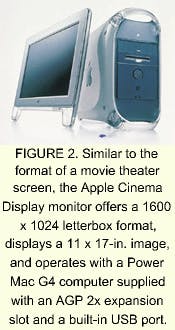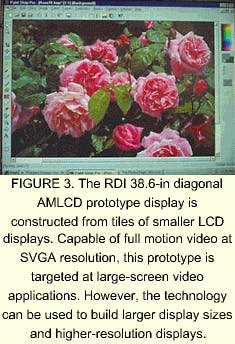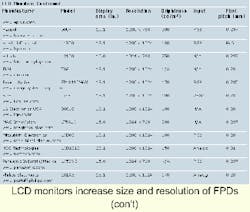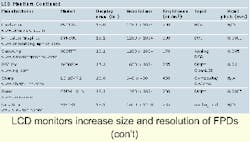CRTs encounter flat-panel displays in imaging applications
In industrial and medical imaging applications, liquid-crystal displays are gaining design wins over their CRT counterparts.
According to The Display Search Monitor, a publication of market-research firm DisplaySearch (Austin, TX), the liquid-crystal-display (LCD) monitor market totaled 3.96 million units shipped last year and is expected to grow to 5.43 million units this year and to 7.5 million units in 2001. According to a cost-of-ownership study performed by the Electronics Industry of Japan, the most important benefits of LCD monitors compared with their cathode-ray-tube (CRT) counterparts are smaller form factor, reduced eyestrain, and lower power consumption. Although the prices for LCD monitors were 71% higher than for CRTs, the total cost of ownership over a five-year period was lower, due mainly to decreased power consumption.
FIGURE 1. In its LCD1810X 18-in. monitor, NEC Technologies has incorporated the DVI-I or DVI-D standard that enables systems integrators to provide both a digital and a legacy analog connection. Dubbed Ambix, the technology also offers compatibility with other TMDS-based digital interfaces such as DFP and P&D.
Just as the broadcast television market lowered the cost of CRTs and computer monitors, LCDs for video applications are projected to lower the cost of flat-panel displays (FPDs). Last year, for example, Sharp (Mahwah, NJ) released its $6000 LC-20VM2C 20-in. LCD monitor that combines component video and RGB (red, green, blue) input. Measuring less than 2 in. deep, this monitor can display 640 x 480 video images at a brightness of 400 cd/m2.
According to the August 1999 issue of Nikkei Microdevices magazine (www.nikkeibp.com), Sharp is selling 2000 displays per month—a figure lower than was originally forecast due to thin-film-transistor shortages. Other vendors expected to enter this market include Samsung (Glenview, IL), LG Electronics USA (Englewood Cliffs, NJ), and Panasonic Industrial/Medical Group (Secaucus, NJ).
Computer-based displays
While FPD vendors are exploring broadcast markets to lower the cost of their displays, they are also looking to compete in the computer-monitor arena. Already, most vendors are offering displays as large as 18.1 in. in diagonal with resolutions of 1280 x 1024. Unlike video displays for the broadcast market, these monitors are targeted toward the computer-peripheral market and feature analog RGB inputs and fine pixel pitches (see table on p. 40). Although 18.1-in. monitors with 1280 x 1024 resolution are available, many vendors have yet to incorporate both a digital visual interface (DVI) and analog interfaces. Lower-resolution 15-in. displays, however, are already incorporating both interfaces.
Developed by the Digital Display Working Group (DDWG; Hillsboro, OR), the DVI standard supports resolutions as high as 2500 x 2500 pixels. The standard currently relies on transmitters and receivers developed by Silicon Image (SiI; Cupertino, CA) to accomplish digital data transfers from graphics or frame-grabber cards to FPDs (see Vision Systems Design, Nov. 1999, p. 36).
FIGURE 2. Similar to the format of a movie theater screen, the Apple Cinema Display monitor offers a 1600 x 1024 letterbox format, displays a 11 x 17-in. image, and operates with a Power Mac G4 computer supplied with an AGP 2x expansion slot and a built-in USB port.
Flat-panel-display vendors that have incorporated SiI's PanelLink signal-interface technology in their flat-panel designs include Compaq Computer (Houston, TX), NEC Technologies (Itasca, IL), ViewSonic (Walnut, CA), and Princeton Graphics (Santa Ana, CA). Last year, for example, Compaq introduced the FP720 digital flat-panel monitor with SiI receivers that can display up to 1024 x 768-pixel resolution images on a 15-in. thin-film-transistor active-matrix liquid-crystal display (AMLCD). The company is now using the SiI 151 PanelLink receiver chip to provide a DVI to its 18-in. TFT8020 monitor.
While direct digital connection is clearly the future interface trend, most of today's video cards produce an analog output. As a result, the DDWG's DVI standard specifies both an integrated analog and a digital connector interface (DVI-I) and a digital-only interface (DVI-D) to legacy and digital monitors. In each specification, the monitor with a digital interface can be attached to either DVI-I or DVI-D system connectors. However, because the digital-only connector does not have sockets for the analog pins of an analog monitor, the analog monitor plugs cannot be connected to digital systems.
In the design of its latest LCD1525X 15-in. and LCD1810X 18-in. LCD monitors, NEC has incorporated both standards to offer systems integrators both digital and legacy analog connections. Dubbed Ambix, the technology also offers compatibility with other transition-minimized-differential-signaling (TMDS) based digital interfaces such as digital flat panel and plug and display, so that early adopters of digital interfaces can also use the displays (see Fig. 1).
By incorporating both the digital and analog components of the DVI specification, Ambix allows for two different types of dual-port connections: either one digital or one analog, or two analog. According to NEC, dual analog connections have been a popular feature on CRT monitors, allowing two computers to be connected to the display simultaneously.
Bigger, better, brighter
As LCD manufacturers continue to incorporate digital and analog interfaces into their latest 18.1-in. displays, they are also looking to increase the size of their displays. However, a recent Vision Systems Design survey of monitor Web sites reveals that only three vendors are currently offering displays greater than 18 in. in diameter: Apple Computer (Cupertino, CA) with its 22-in. Cinema Display, NEC with its LCD2010, and Sharp with its LC-20VM2.
FIGURE 3. The RDI 38.6-in diagonal AMLCD prototype display is constructed from tiles of smaller LCD displays. Capable of full motion video at SVGA resolution, this prototype is targeted at large-screen video applications. However, the technology can be used to build larger display sizes and higher-resolution displays.
Although the Sharp display features 640 x 480 video resolution and a composite/S-Video input, the 20-in. FPD is targeted at broadcast video and consumer applications. Unlike this display, both the Apple Cinema Display and the NEC LCD2010 display are primarily for use as PC-based displays.
Perhaps the most elegant LCD to date, the Apple Cinema Display features a 1600 x 1024 display, a 24-pin DVI connector, and a TDMS interface. Similar in format to a movie-theater screen, the Cinema Display's letterbox format can depict a full 11 x 17-in. image and can operate with a Power Mac G4 computer supplied with an AGP 2x expansion slot and a built-in USB port (see Fig. 2).
Although this Apple display is large, it does not support the XGA (1024 x 768), SXGA (1280 x 1024), or UXGA (1600 x 1200) standards. Following a more conventional route, however, the SXGA resolution of the NEC LCD2010 displays 1280 x 1024 images across a 20.1-in. screen.
FIGURE 4. The DVDO DV103 Image Enhancement Engine is a single-chip all-format NTSC/PAL/SECAM video de-interlacer that provides a full-motion video-on-LCD platform for LCD-TV by directly driving VGA-resolution TFT LCD panels.
While some manufacturers are developing 18.1-in. FPDs, others are looking to leverage the cost of producing smaller LCDs in larger tiled displays. Last year, for example, Rainbow Displays Inc. (RDI; Endicott, NY) joined with Philips Flat Display Systems (San Jose, CA) to produce 36-in.-diagonal displays. In RDI's proprietary tiling technology, smaller AMLCD panels are formed into a larger singular display and packaged with backlights in rugged and durable mechanical housings.
Already the company has developed a 38.6-in.-diagonal AMLCD prototype capable of full motion video at SVGA resolution (see Fig. 3). Like Sharp's LC-20VM2, the RDI prototype is targeted at large-screen video applications. But, according to RDI, the technology is scalable and capable of achieving larger display sizes, higher resolutions, and multiple configurations.
DVI gains momentum
Even before many flat-panel-monitor vendors have introduced products that conform to the new DVI specification, IC vendors are beginning to offer faster and more highly integrated products. Already, Silicon Image, Texas Instruments (Dallas, TX), and THine Electronics (Tokyo, Japan) are producing low-voltage differential signaling and DVI chipsets to drive LCD displays.
At the recent Intel Developer's Forum in Palm Springs, CA, THine Electronics showed a range of DVI-compliant silicon transmitters, receivers, and evaluation boards. The THC63DV161 and THC63DV164 DVI-compliant chipsets for flat-panel monitors support display resolutions from VGA (640 x 480) to UXGA (1600 x 1200) through the digital display interface. The THC63DV164 transmitter and the THC63DV161 receiver cover the frequency range of 25 to 170 MHz through a single DVI link. The THC63DV154 and THC63DV151 transmitters cover display resolutions from VGA to SXGA.
Other companies are also looking to integrate greater functionality into their LCD products. For example, DVDO (Campbell, CA), a fabless semiconductor company recently purchased by Silicon Image, has developed ICs for video, Internet-enabled, and interactive set-top products. The company's latest product, the DV103 Image Enhancement Engine, is a single-chip all-format NTSC/PAL/ SECAM video de-interlacer that enables a full-motion video-on-LCD solution for LCD-TV by directly driving VGA-resolution TFT LCD panels (see Fig. 4).
Other manufacturers developing systems-on-a-chip solutions include Chrontel (San Jose, CA) and Genesis Microchip (Thornhill, Ontario, Canada). The Chrontel CH700X product family interfaces to VGA controllers and converts noninterlaced VGA outputs to standard interlaced TV signals. The company's latest offering, the CH7009, is a single chip that combines Chrontel's encoder technology with a TMDS link to display images as large as 1024 x 768 pixels.
Consumer and computer combine
As analog data continue to be digitized, processed, and displayed using digital methods, LCDs are expected to converge and combine the best aspects of both high-resolution computer-based displays and video-based monitor displays. This convergence of technologies has many content providers (such as entertainment producers) worried. To protect their intellectual property rights, they have proposed several safeguard standards.
To protect digital entertainment content transmitted and received via DVI interfaces, for example, Intel Corp. (Santa Clara, CA) has developed the High-Bandwidth Digital Content Protection (HDCP) standard. The HDCP stakeholders include the PC and monitor industries, consumer electronics manufacturers, and movie studios—all of whom are developing secure digital video content delivery systems for PC monitors, DVD players, set-top boxes, and digital TVs.
To provide property protection in a PC or a monitor, designers are turning to such devices as the gm3020 from Genesis Microchip. With the same functionality as the company's gmZRX1 chip, the device includes an integrated TMDS receiver; HDCP, video, and color enhancement support; and integrated gamma correction and dithering. Optimized for LCD monitors, the gmZRX1 delivers input and output resolutions up to SXGA at 75 Hz with single-pixel data rates up to 135 MHz.
In the near term, rapid developments in resolution and performance of LCDs coupled with semiconductor receivers, transmitters, and video ICs are anticipated to combine consumer- and computer-type displays. When these new displays emerge, they are expected to provide minimum 20.1-in. displayable image areas and resolutions of 1280 x 1024 pixels and higher. With direct digital interfaces, such displays are also envisioned to incorporate a 640 x 480 "video-in-window" display, image scaling, and digital data-copyright protection.
Company Information
For information on additional suppliers of flat-panel displays, see the 2000 Vision Systems Design Buyers Guide (Vision Systems Design, Feb. 2000, p. 85).
Chrontelv
San Jose, CA 95131
Web: www.chrontel.com
Digital Display Working Group
Hillsboro, OR
DisplaySearch
Austin, TX 78731Web: www.displaysearch.com
DVDO
Campbell, CA 95008
Web: www.dvdo.com
Genesis Microchip
Thornhill, Canada L3T 7V8
Intel Corp.
Santa Clara, CA 95052
Web: www.intel.com
Rainbow Displays
Endicott, NY 13760
Web: www.rainbowdisplays.com
Silicon Image
Sunnyvale CA 94086
Web: www.siimage.com
Texas Instruments
Dallas, TX 75265
Web: www.ti.com
Thine Electronics
Chuo-ku, Tokyo, 104-0032 Japan
Web: www.thine.co.jp




